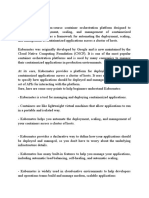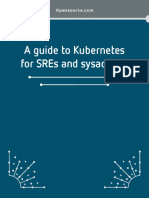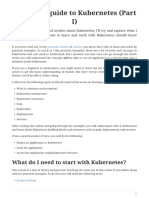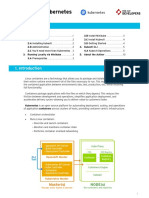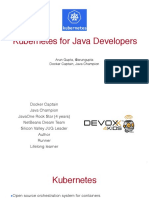0 ratings0% found this document useful (0 votes) 22 views2 pagesKubernetes
Copyright
© © All Rights Reserved
We take content rights seriously. If you suspect this is your content,
claim it here.
Available Formats
Download as PDF or read online on Scribd
Powered by AL
Bing
Certainly! Kubernetes is a powerful container orchestration platform that helps manage and deploy containerized
applications. Here’s a high-level guide on how to use Kubernetes:
|, Understanding Kubernetes Basics:
© Start by grasping the fundamental concepts:
= Nodes: These are the worker machines where containers run.
= Pods: The smallest deployable units in Kubernetes, containing one or more containers
= Services: Expose pods to the network
= ReplicaSets: Ensure a specified number of replicas of a pod are running,
= Deployments: Manage rolling updates and rollbacks.
© Explore the Kubemetes Basics tutorial for an interactive learning experience.
2, Setting Up a Kubernetes Cluster:
© Choose a cluster setup:
= Local Development: Use tools like Minikube or Kind to create a single-node cluster on your
local machine.
= Cloud Providers: Set up a cluster on cloud platforms like Google Kubernetes Engine (GKE),
Amazon Elastic Kubernetes Service (EKS), or Azure Kubernetes Service (AKS)
© Install kubectl, the Kubernetes command-line tool, to interact with your cluster.
3. Creating and Managing Resources:
© Write YAML manifests for Kubemnetes resources (pods, services, deployments, ete.).
© Use kubect] apply -f to create or update resources.
© Explore the official Kubernetes tutorials for practical examples.
4, Deploying Applications:
© Define your application’s components (pods, services, ete.) in YAML files.
© Apply these manifests to your cluster using kubect1 apply.
© Monitor the deployment using kubect1 get pods, kubect logs, and other commands
5. Scaling and Updating:
© Scale your application by adjusting the replica count in a Deployment.
© Update your app by modifying the YAML files and applying changes.
© Use Rolling Updates to ensure zero-downtime deployments.
6. Service Discov
'y and Load Balancing:
© Create a Service to expose your app to the network.
© Use Ingress Controllers for more advanced routing and load balancing,
7. Monitoring and Loggi
fg:
© Set up monitoring tools like Prometheus and Grafana.
© Collect logs using Fluentd or Elastiesearch.
8. Security and Access Control:
© Implement RBAC (Role-Based Access Control) to manage permis
© Secure communication using TLS certificates.
© Explore Network Policies for fine-grained control.
ions.�9. Advanced Topics:
© Learn about StatefulSets, DaemonSets, and CronJobs.
© Explore Custom Resource Definitions (CRDs) for extending Kubernetes.
10. Explore Tutorials and Documentation:
© Dive deeper into specific topics by following tutorials:
= Kubernetes Tutorial
= Red Hat Developer Kubernetes Tutorials
= GeeksforGeeks Kubernetes Tutorial
= DevOpsCube Kubermetes Tutorials
Remember, Kubernetes is vast, so take it step by step, practice, and explore the rich eco:






